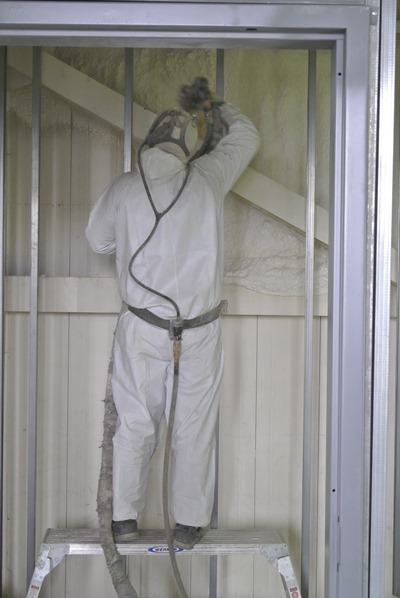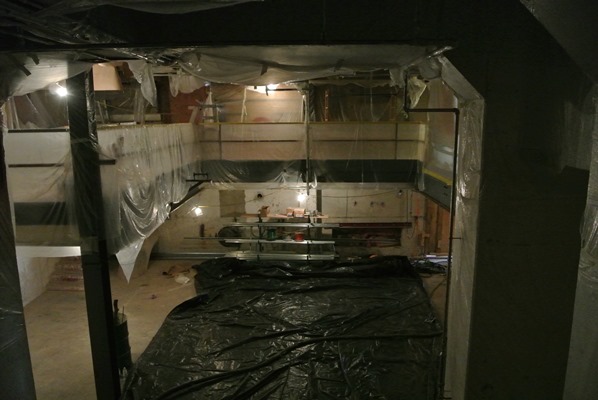When Owatonna, Minnesota, suffered a major flood in September 2010, the historic Owatonna Power Plant — home to a couple of Owatonna Public Utilities (OPU) and water utility offices — was right in the path of the watery destruction. Sitting next to the Straight River in an isolated low point, the area collects storm water and has experienced flooding in the past. Yet the 2010 storm is when real damage to the building was done. The basement was submerged in 12 feet (3.7 m) of water, which wiped out its power-generation equipment.
After much debate and deliberation, the fate of the landmark building was decided: The water utility offices that were there would be permanently moved into a flood-safe zone, but OPU would stay put. The building would be converted into a space so that all OPU offices could be under one roof.
As part of this extensive renovation project, the lower level of the building — an 83,000-square-foot (7,710.9 m²) space where all the mechanical equipment is housed — needed to be insulated. However, the age of the building, the ducting and mechanical systems it contained, and the requirements of the renovations made the traditional option of fiberglass and sheetrock nearly impossible.
That’s how Greener World Solutions (GWS), a spray polyurethane foam (SPF) installation company based in Waseca, Minnesota, entered the equation.
Winning System
According to Dan Bulfer, owner of GWS, SPF, also called spray foam, was clearly the top choice for the job. Not only an economical option, it could easily be applied to the concrete block walls and in and around the ductwork, stairwells, and catwalks located on this level.
Plus, SPF provides a “vapor barrier that would stick to the unique substrate and give maximum R-value,” Bulfer added, referring to its heat-resistance capacity. “The downfall to the product,” he noted, “is it does not provide a thermal barrier. That’s where the (intumescent) coatings come in.”
International Residential and International Building codes require that SPF be separated from the interior of a building by a thermal barrier, which is applied over the spray foam to slow thermal rise during a fire, and delays its involvement in a fire.
In this case, the team used Paint to Protect’s DC 315 as an alternative thermal barrier coating system, which also met the City of Owatonna’s code of a 15-minute fire barrier.
Getting Down to Work
Before any coating could be applied, the first step the 10-person crew from GWS needed to do was to make sure the  substrate was clean and dry. They removed any foreign matter with a wire brush and pressure washer. Then, they needed to remove any humidity/moisture from the substrate, which they accomplished by employing large propane heaters and “superheating” the space.
substrate was clean and dry. They removed any foreign matter with a wire brush and pressure washer. Then, they needed to remove any humidity/moisture from the substrate, which they accomplished by employing large propane heaters and “superheating” the space.
Next, they prepared and wrapped all external surfaces that could not be spray foamed, including all the piping and heat ducts.
Using the Graco Reactor 2 H-30, they applied Covestro’s Bayseal 2.7, a two-component, closed-cell SPF that, according to Covestro’s technical sheets, creates a “seamless air barrier system that provides exceptional building envelope performance.” It also acts as a moisture barrier — a key upgrade to a building prone to flooding. That layer was applied to achieve an average thickness of 3 inches (7.6 cm).
Because SPF has a quick cure of about an hour, Bulfer said there were no delays in applying the DC 315 over the foam. He noted that he really likes the intumescent coating since “it is very adaptable to the different contours that the spray foam challenges.” Plus, it is “simple to apply” and “sprays very easily with the proper equipment.”
The proper equipment on this project was the Graco 833 Big Rig, a workhorse that quickly gets the job done. Before pouring in the DC 315, the crew needed to mix it to a “creamy” consistency; no lumps were allowed.
Bulfer said two to three applications of DC 315 were needed to get the proper average depth of 24 mils (609.6 microns) wet film thickness (WFT).
Because the client also wanted the flooring system on the level above to be protected against moisture, the crew also coated the basement-level ceiling with SPF and DC 315, again at an average of 3 inches (7.6 cm) and 24 mils (609.6 microns) WFT, respectively.
There were some hard-to-reach places, so the team needed to use a system of lifts, ladders, and planks. Taking the proper precautions, they used Southern Minnesota Inspection safety harness lanyards. And due to the nature of the chemicals they were applying, they also donned 3M face mask respirators.
A Little Advice
Bulfer offered other SPF installers a tip to save themselves time and therefore money: “Be sure to double check the specs, and make sure that the architect understands the products and how they work and are applied,” he said, suggesting installers go over these critical details before the start of a project to ensure they fit in with the architect’s and other subcontractors’ requirements and, thus, create efficiency.
Yet, efficiency wasn’t really in the cards for this project. There were a couple of uncontrollable factors that hindered GWS’s timeline. Because Bulfer and his crew were waiting on a number of other subcontractors to complete their tasks before they were able to get started on theirs, GWS could only work section by section.
“There was a lot of skipping around, waiting for the other trades — plumbers, electricians, framers — to finish,” Bulfer said, noting there were usually 25 to 50 other workers on the jobsite at any given time.
Because of the way they had to conduct their work, the project was drawn out for a year. Under different circumstances, Bulfer said, it should have taken four weeks.
Also slowing them down was another storm that flooded the area during the middle of their project. This caused problems with getting their trucks in and out as well as subsequent delays.
Fortunately, the water did not enter into the jobsite — it simply did not reach that far. And while the work Bulfer and his crew performed won’t prevent any further flooding in the basement, it won’t get ruined like sheetrock. More importantly, because the vapor barrier will prevent moisture from seeping through, the important mechanical equipment behind will remain high and dry.
